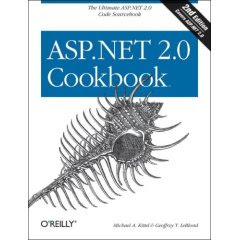
Paperback: 1014 pages
Publisher: O'Reilly Media, Inc.; 2 edition (December 16, 2005)
Language: English
ISBN-10: 0596100647
ISBN-13: 978-0596100643
Product Dimensions: 9.1 x 7 x 1.6 inches
Completely revised for ASP.NET 2.0, this new edition of the best-selling ASP.NET Cookbook has everything you need to go from beginning to advanced Windows-based web site development using Microsoft's popular Visual Studio 2005 and ASP.NET 2.0 developer tools. Written for the impatient professional, ASP.NET 2.0 Cookbook contains more than 125 recipes for solving common and not-so-common problems you are likely to encounter when building ASP.NET-based web applications.
The recipes in this book, which run the gamut from simple coding techniques to more comprehensive development strategies, are presented in the popular Problem-Solution-Discussion format of the O'Reilly Cookbook series. As with the first edition, every solution is coded in both C# and Visual Basic 2005.
Among the additions and revisions to this new edition are:
Three new chapters, including 25 new recipes for Master and Content pages, Personalization using Profiles and Themes, Custom Web Parts, and more
New code for every solution, rewritten to take advantage of features and techniques new to ASP.NET 2.0 and available for download
The ASP.NET 2.0 Cookbook continues to provide the most comprehensive coverage you'll find anywhere of:
Tabular controls, including the new GridView control
Data validation, including the new ASP.NET 2.0 validation controls, as well as techniques for performing your own validation programmatically
User and custom controls
Error handling, performance tuning, and caching
Whether you're new to ASP.NET or an experienced Microsoft developer, with ASP.NET 2.0 Cookbook, deliverance from a long day (or night) at your computer could be just one recipe away.
User Review:
There are lots of tips and tricks in this book on ASP.NET 2.0 presented in a "Problem: Solution" format that make it a worthwhile timesaver for experienced developers. Code is shown for both VB.NET and C#.
The problem I have is that is little or no discussion of alternatives or the circumstances when a particular recipe should be used. This means inexperienced developers might implement recipes that work for their immediate problem but add maintenance, performance or architectural issues down the road.
For example, there are 72 pages on using the DataGrid control. Except for backward compatibility there is no valid reason to use the DataGrid in ASP.NET 2.0 -- use the GridView control instead. I'd go so far as to say use of the DataGrid in 2.0 is deprecated -- don't do it in new code.
Likewise the data binding examples use SqlDataSource -- never XMLDataSource or, importantly, ObjectDataSource. ObjectDataSource is the way to go when we want to build a modern architecture application where we have separated business logic, data access code, and the UI.
It appears that this book was written quickly to get something out for the 2.0 market before the "2.0ness" of the recipes was fully baked in.
Free download:


No comments:
Post a Comment